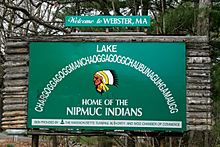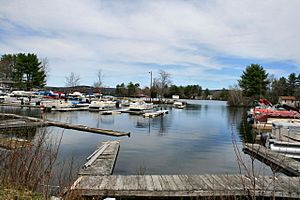Webster/Dudley Band of Chaubunagungamaug Nipmuck Indians facts for kids
 |
|
| Total population | |
|---|---|
| 354 (2002). | |
| Regions with significant populations | |
| United States of America |
|
| Languages | |
| English, Nipmuck, Massachusett | |
| Religion | |
| Christianity, Indigenous religion | |
| Related ethnic groups | |
| Other Nipmuc people, Massachusett, Wampanoag, Narragansett, Pennacook, Pocomtuc, Pequot, Mohegan and other Algonquian peoples |
The Webster/Dudley Band of Chaubunagungamaug Nipmuck Indians is a group of Native American people. They are originally from parts of Massachusetts and Connecticut in the New England area. They are also known as the Chaubunagungamaug Nipmuck or Dudley Indians.
This tribe is currently not officially recognized by the U.S. government (not federally recognized). They are also not recognized by the state of Massachusetts, unlike another group called the Nipmuc Nation.
The ancestors of this tribe lived between Lake Chaubunagungamaug and the Maanexit River. English settlers first met them in the 1630s. By the 1670s, the Chaubunagungamaug Nipmuck were influenced by the Massachusetts Bay Colony. A special village called a 'Praying Town' was set up for them in 1674.
After a difficult time during King Philip's War (1675-1676), the tribe was given a special land area (a reservation) in 1682. This land was sold in 1870, which caused the tribe members to spread out and live among other communities.
The tribe officially formed again in 1981. They use private land in Webster, Massachusetts and Thompson, Connecticut as their home base. For a while, they worked closely with the Hassanamisco Nipmuc to try and get federal recognition. However, the Webster/Dudley Band separated from the Nipmuc Nation in 1996. Even so, many Chaubunagungamaug Nipmuck people are still connected to the Nipmuc Nation. The U.S. government denied the tribe's request for federal recognition in 2001, 2004, and 2007.
Contents
Understanding the Tribe's Names
The Chaubunagungamaug Nipmuck prefer to spell their name Nipmuck instead of Nipmuc. The word Nipmuck comes from nippamaug, which means "freshwater fishing pond."
The name Chaubunagungamaug comes from Webster Lake. This name means "divided fishing place" or "fishing place at the boundary." This is because the lake used to be split into different fishing areas. One part was for the Nipmuck who lived in a village also called Chabunagungamag. Another related Nipmuck group lived to the south of the lake.
For a long time in the 1700s, these Nipmuck people were often called the Pegan Indians. This was because many members of the tribe had the last name Pegan. The word Pegan means 'clear' or 'bare,' like a treeless area.
English settlers and other new groups often called the Nipmuck near the lake by the name of their location. When they were part of the 'Praying Towns,' they were known as the Praying Indians of Chabanakongkomun. Their reservation lands were in the town of Dudley, Massachusetts. Later, some of this land became part of the town of Webster, Massachusetts. Because of this, they were also called the Dudley, Webster-Dudley, or Webster Indians.
In 1996, the tribe officially chose their current name: Webster/Dudley Band of the Chaubunagungamaug Nipmuck Indians.
Where the Tribe Lived
The Nipmuck homeland was called Nippenet, meaning 'freshwater (pond) place'. This area had many small ponds and lakes. It covered most of central Massachusetts and nearby parts of north-eastern Connecticut and north-western Rhode Island.
The Chaubunagungamaug people lived mainly between Lake Chaubunagungamaug and the Maanexit River. This area includes towns like Dudley, Southbridge, Webster, Charlton, Oxford, Sutton, and Douglas in southern Worcester County, Massachusetts. It also includes the town of Thompson in Windham County, Connecticut.
The main village of Chaubunagungamaug was north of the lake, in what is now Webster. Over time, their reservation lands became smaller. Today, a few acres around the lake in Webster are still used by the tribe as their reservation.
Who Can Join the Tribe
To become a member of the tribe, a person must be a direct descendant of the "Dudley Indians." These ancestors were listed in official reports from 1861 or in court lists from 1890. Some of the family names of Dudley Indians from the 1861 report include Bakeman, Beaumont, Belden, Cady, Corbin, Daley, Dorus, Esau, Fiske, Freeman, Henry, Hull, Humphrey, Jaha, Kyle, Nichols, Oliver, Pegan, Robinson, Shelley, Sprague, White, Willard, and Williard. In 2004, the tribe had 354 members.
How the Tribe is Governed
Since 1981, the tribe has been led by descendants of Sachem (Chief) Edwin "Wise Owl" Morse, Sr. The current chief is Sachem Edwin Morse III.
Since 1996, the tribe has had its own elected council. The council members are elected for three-year terms. Elections happen at the end of December. As of November 2013, the council included Chairman/Treasurer Kenneth White and Vice-Chairman David White. Other members included Secretary Sherry Davis, Enrollment Committee Chairperson Stacey Kelleher, Resident Agent Tom Morse, Claudia Zatorski, Barbi Gardiner, and Melissa Greene. Council members must come from certain family lines within the tribe.
Chiefs Since 1981
- Sachem Edwin Wise Owl Morse, Sr., served from 1981 to 2010.
- Sachem Edwin Red Fox Morse, Jr., served from 2010 to 2013.
- Sachem Edwin Spring Fox Morse III, has been the chief since 2013.
Working with Other Nipmuck Groups
The Webster/Dudley Band and the Hassanamisco Nipmuc (including those in the Nipmuc Nation) have sometimes had disagreements. However, their close family ties and shared cultural interests have helped them work together.
Today, the two tribes are working to bring back the Nipmuck language. They are also involved in projects like Project Mishoon, which explores ancient canoes. They are looking into using land for a Nipmuck cultural center.
Other Nipmuck groups, like the Connecticut Nipmuck and the Quinsigamond Nipmuck, also exist. All Nipmuck people often attend each other's powwows, Indian fairs, and social gatherings. The Chaubunagungamaug Nipmuck, Hassanamisco Nipmuck, and Natick Massachusett tribes work with the Massachusetts Commission on Indian Affairs to support Native peoples.
Important People from the Tribe
Chiefs and Leaders
- Sachem Willymachin 'Black James,' a chief in the 1600s.
- Sachem James, son of Willymachin, a chief in the 1600s.
- Sachem Simon, son of Willymachin, a chief in the 1600s.
- Joseph, a teacher in the Praying Town of Chabanakongkomun in the 1600s.
- Sachem Edwin Wise Owl Morse, Sr., chief from 1981 to 2010.
- Sachem Edwin Red Fox Morse, Jr., chief from 2010 to 2013.
- Sachem Edwin Spring Fox Morse III, the current chief.
- David Tall Pine White, a tribal councilor and language teacher. He also worked as a language consultant and actor for the We Shall Remain mini-series.
Veterans
Many members of the tribe have served in the military:
- Joshua Ephraim, American Revolutionary War Veteran, 1700s.
- Eleazer Pegan, American Revolutionary War Veteran, 1700s.
- Josiah Pegan, American Revolutionary War Veteran, 1700s.
- Joseph Pegan, Jr., American Revolutionary War Veteran, 1700s.
- Josiah Pegun, American Revolutionary War Veteran, 1700s.
- Hezekiah Dorus, Civil War Veteran, 1800s.
- Joseph E. Bowman, Civil War Veteran, 1800s.
- William H. Cady, Civil War Veteran, 1800s.
- Joseph H. P. White, Civil War Veteran, 1800s.
- James M. Pegan, Civil War Veteran, 1800s.
- Theophilus D. Freeman, Civil War Veteran, 1800s.
- Israel Henries, World War I Veteran, 1900s.
- Earl Edward Henries, World War II draftee, 1900s.
People Called 'Last of the Nipmucks'
Some people were known as the 'last of the' or 'last full-blooded' Nipmuck:
- Angela Lynch, who passed away in 1914.
- Matilda Maria Henries, who passed away in 1920.
- Henry E. Dorus, who passed away sometime after 1936.
- Payne Henries, who passed away sometime after 1930.
See also


